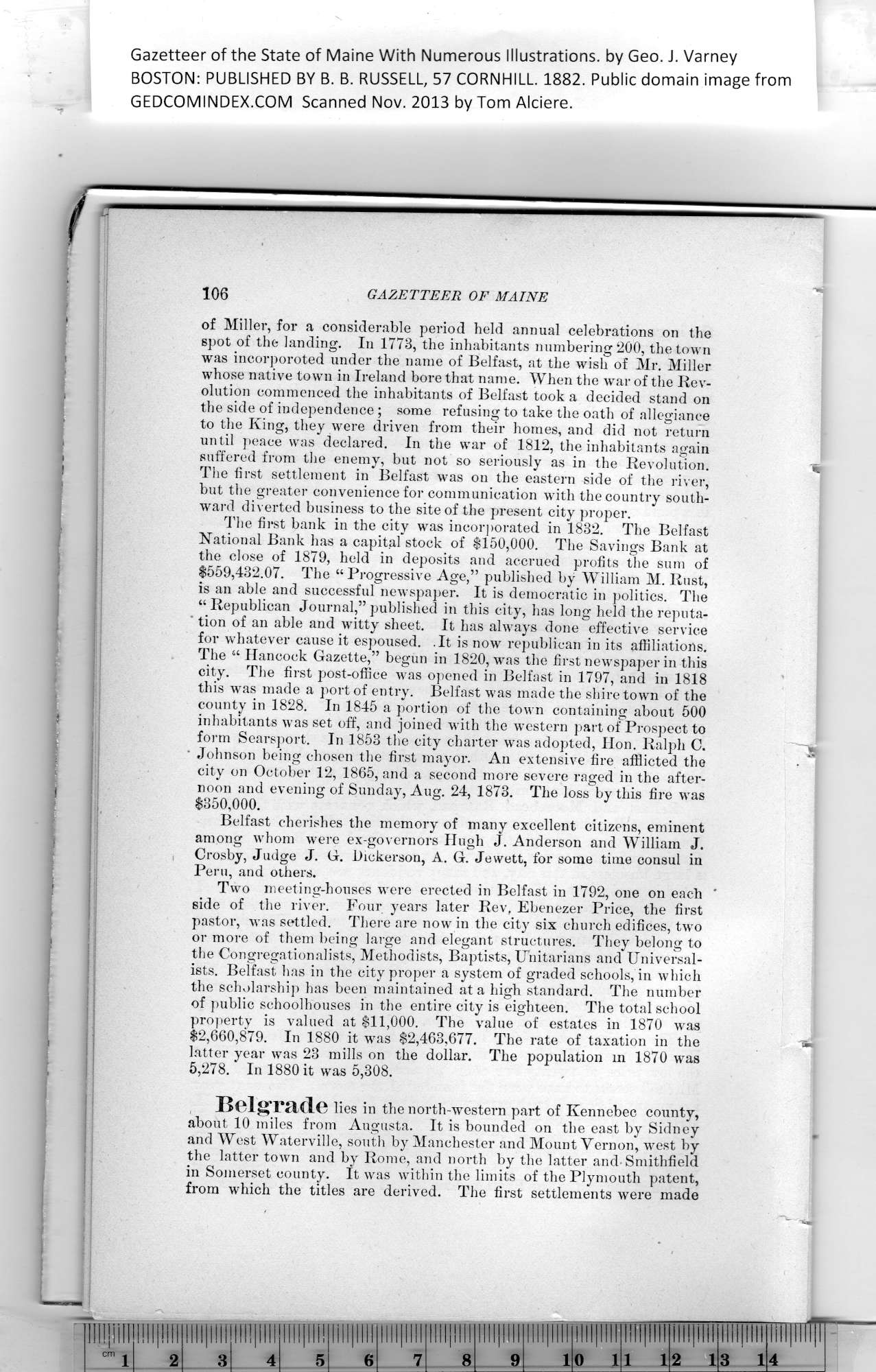|
Gazetteer of the State of Maine With Numerous Illustrations, by Geo. J. Varney
BOSTON: PUBLISHED BY B. B. RUSSELL, 57 CORNHILL. 1882. Public domain image from
106 GAZETTEER OF MAINE
of Miller, for a considerable period held annual celebrations on the
spot of the landing. In 1773, the inhabitants numbering ‘200, the town
was incorporoted under the name of Belfast, at the wish of Mr. Miller
whose native town in Ireland bore that name. When the war of the Rev-
olution commenced the inhabitants of Belfast took a decided stand on
the side of independence; some refusing to take the oath of allegiance
to the King, they were driven from their homes, and did not return
until peace was declared. In the war of 1812, the inhabitants again
suffered from the enemy, but not so seriously as in the Revolution.
The first settlement in Belfast was on the eastern side of the river,
but the greater convenience for communication with the country south-
ward diverted business to the site of the present city proper.
The first bank in the city was incorporated in 1832. The Belfast
National Bank has a capital stock of $150,000. The Savings Bank at
the close of 1879, held in deposits and accrued profits the sum of
$559,432.07. The “ Progressive Age,” published by William M. Rust,
is an able and successful newspaper. It is democratic in politics. The
“ Republican Journal,” published in this city, has long held the reputa-
tion of an able and witty sheet. It has always done effective service
for whatever cause it espoused. .It is now republican in its affiliations.
The “ Hancock Gazette,” begun in 1820, wms the first newspaper in this
city. The first post-office was opened in Belfast in 1797, and in 1818
this was made a port of entry. Belfast was made the shire town of the
county in 1828. In 1845 a portion of the town containing about 500
inhabitants was set off, and joined with the western part of Prospect to
form Searsport. In 1853 the city charter was adopted, Hon. Ralph C.
' Johnson being chosen the first mayor. An extensive fire afflicted the
city on October 12, 1865, and a second more severe raged in the after-
noon and evening of Sunday, Aug. 24, 1873. The loss by this fire was
$350,000.
Belfast cherishes the memory of many excellent citizens, eminent
among whom were ex-governors Hugh J. Anderson and William J.
, Crosby, Judge J. G. Dickerson, A. G. Jewett, for some time consul in
Peru, and others.
Two meeting-houses were erected in Belfast in 1792, one on each '
side of the river. Four years later Rev, Ebenezer Price, the first
pastor, was settled. There are now in the city six church edifices, two
or more of them being large and elegant structures. They belong to
the Congregationalists, Methodists, Baptists, Unitarians and Universal-
ists. Belfast has in the city proper a system of graded schools, in which
the scholarship has been maintained at a high standard. The number
of public schoolhouses in the entire city is eighteen. The total school
property is valued at $11,000. The value of estates in 1870 was
$2,660,879. In 1880 it was $2,463,677. The rate of taxation in the
latter year was 23 mills on the dollar. The population in 1870 was
5,278. In 1880 it was 5,308.
Belgrade lies in the north-western part of Kennebec county,
about 10 miles from Augusta. It is bounded on tbe east by Sidney
and West Waterville, south by Manchester and Mount Vernon, west by
the latter town and by Rome, and north by the latter and Smithfield
in Somerset county. It was within the limits of the Plymouth patent,
from which the titles are derived. The first settlements were made
PREVIOUS PAGE ... NEXT PAGE
This page was written in HTML using a program written in Python 3.2
|
